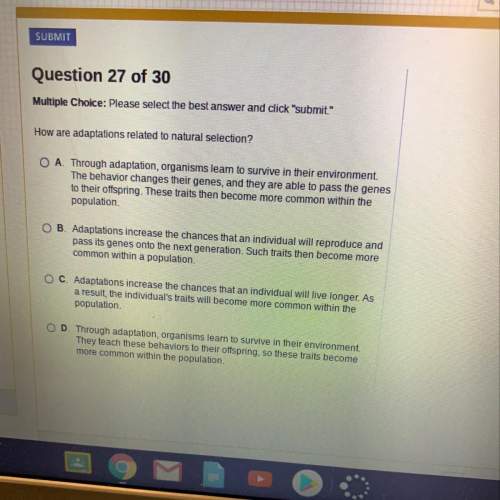
Biology, 16.09.2019 19:30 martinhannaheovgtjp
In 1967 a penicillin-resistant pneumonia, caused by streptococcus pneumoniae and called pneumococcus, surfaced in a remote village in papua, new guinea. at about the same time american military personnel in southeast asia were acquiring penicillin-resistant gonorrhea from prostitutes. by 1976, when the soldiers had come home, they brought the new strain of gonorrhea with them and physicians had to find new drugs to treat it. in 1983 a hospital-acquired intestinal infection caused by the bacterium enterococcus faecium joined the list of bacteria that could not be killed by penicillin. which of these best describes why certain bacteria have become resistant to penicillin?

Answers: 2
Another question on Biology

Biology, 21.06.2019 14:30
Acladogram is a branching diagram that represents suggested evolutionary relationships among organisms based on the presence of unique traits. a scientist discovers a new organism that lacks limbs and does not have a true backbone. the organism lays eggs to produce offspring and has a cartilage-like rod known as a notochord running along its dorsal surface. on the cladogram below, select the species to which the newly discovered organism is most closely related.
Answers: 1

Biology, 21.06.2019 20:30
Match the descriptions / definitions with the term they best describe 1. three dimensional relationship of the different polypeptide chains in a multisubunit protein or protein complex 2. common folding pattern in proteins in which a linear sequence of amino acids folds into a right-handed coil stabilized by internal hydrogen-bonding between polypeptide backbone atoms. 3. the amino acid sequence of a protein 4. a region on the surface of a protein that can interact with another molecule through noncovalent bonding. 5. three-dimensional arrangement of alpha-helices and beta-sheets within a single polypeptide, typically stabilized by a variety of noncovalent bonds, including ionic and hydrogen bonds, and nonpolar interactions / hydrophobic force. 6. the chain of repeating carbon and nitrogen atoms, linked by peptide bonds, in a protein. 7. common structural motif in proteins in which different sections of the polypeptide chain run alongside each other and are joined together by hydrogen bonding between atoms of the polypeptide backbone. 8. portion of a polypeptide chain that has a discrete tertiary structure of its own and can often fold independently of the rest of the chain 9. regular local folding patterns in a protein, including alpha-helix and beta-sheet a. primary structure b. beta-sheet c. protein d. coiled-coil e. polypeptide backbone f. secondary structure g. side chain h. tertiary structure i. binding site j. alpha-helix k. quaternary structure l. protein domain
Answers: 2

Biology, 22.06.2019 09:00
The two tubes contain bromothymol blue. after 24 hours, what will the color of the water be in tube b? a. green (it won't change) b. yellow c. blue d. colorless (clear)
Answers: 1

Biology, 22.06.2019 09:30
The ruiz family is exchanging euros for us dollars. the exchange rate is 1 euro equals 1.35261 usd. since the ruiz family knows that usd are stated to the nearest hundredth of a dollar, they used the conversion ratio
Answers: 1
You know the right answer?
In 1967 a penicillin-resistant pneumonia, caused by streptococcus pneumoniae and called pneumococcus...
Questions

Mathematics, 01.12.2020 06:30



Mathematics, 01.12.2020 06:30

Mathematics, 01.12.2020 06:30

Arts, 01.12.2020 06:30


Mathematics, 01.12.2020 06:30


Mathematics, 01.12.2020 06:30


English, 01.12.2020 06:30



Mathematics, 01.12.2020 06:30

History, 01.12.2020 06:30

Mathematics, 01.12.2020 06:30

Mathematics, 01.12.2020 06:30

Mathematics, 01.12.2020 06:30

History, 01.12.2020 06:30




